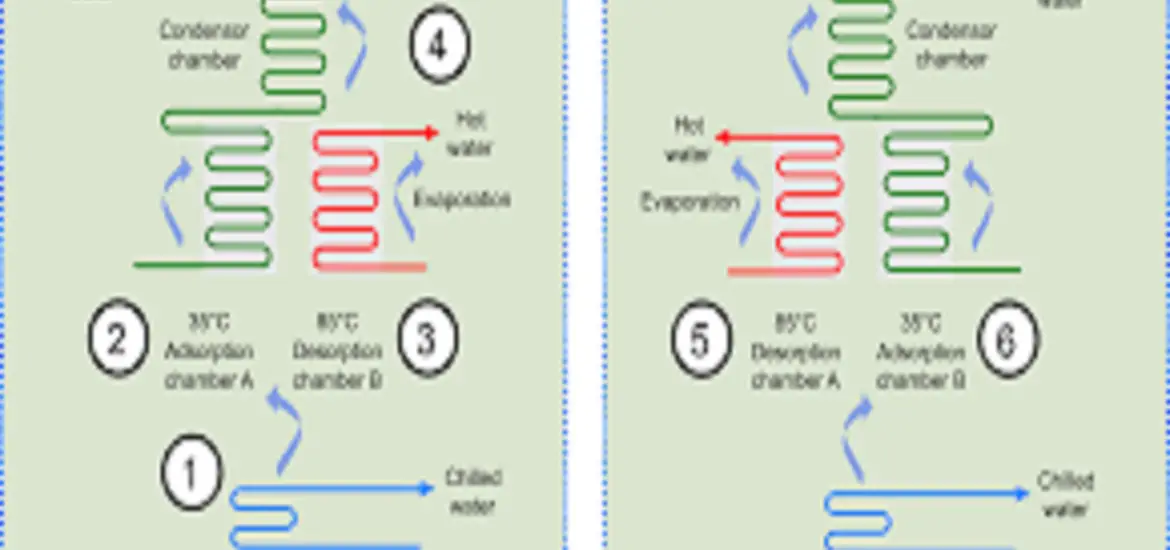Residential absorption chillers are revolutionizing the way we cool our homes. With their energy efficiency, quiet operation, and low maintenance, these innovative systems provide a practical and eco-friendly alternative to traditional air conditioning. But how do they work? And are they the right fit for your home? Read on to find out.

Table of Contents
Introduction to Residential Absorption Chillers
Definition of Absorption Chiller
Absorption chillers are a type of cooling system that use heat energy to generate chilled water or air. Unlike conventional air conditioners that rely on compressors and refrigerants, absorption chillers work through a process of heat absorption and evaporation. The result? A more energy-efficient and environmentally-friendly way to keep your home cool.
Types of Absorption Chillers
There are three main types of absorption chillers: single-effect, double-effect, and triple-effect. Single-effect chillers are the simplest and most common, while double and triple-effect chillers offer increased efficiency by using multiple stages of heat absorption. Each type has its pros and cons, so it’s essential to consider your specific needs before choosing one.
For more information on absorption chillers click here – – Absorption Refrigeration: Easy Guide to Understanding It
Benefits of Absorption Chiller Residential Units
Energy Efficiency
One of the main advantages of absorption chillers is their energy efficiency. Since they use heat energy instead of electricity, they have a smaller carbon footprint compared to traditional air conditioning systems. Plus, their lower operating costs can save you money on your energy bills in the long run.
Quiet Operation
No one likes a noisy air conditioner, right? Absorption chillers are known for their whisper-quiet operation, thanks to the absence of noisy compressors. This means you can enjoy a comfortable living environment without the constant hum of a traditional air conditioner.
Low Maintenance
Another perk of absorption chillers is their low maintenance requirements. With fewer moving parts than conventional air conditioners, they experience less wear and tear, resulting in a longer lifespan and less frequent repairs. It’s a win-win!
Applications of Absorption Air Conditioning Residential Units
Single-family Homes
When it comes to single-family homes, there are a few key factors to consider when installing an absorption chiller: capacity requirements, integration with existing HVAC systems, and installation challenges. While it may require some initial planning and investment, the long-term benefits can be well worth it.
Multi-family Residential Buildings
Absorption chillers are also a great option for multi-family residential buildings, offering both centralized and decentralized cooling solutions. Not only can they help reduce overall energy consumption, but they can also lead to significant cost savings for building owners and occupants alike.
Retrofitting Older Buildings
Thinking of upgrading your older building’s cooling system? Absorption chillers might be the answer. They offer numerous advantages over traditional air conditioning systems, including energy efficiency and reduced environmental impact. However, be prepared for potential installation challenges and the need to secure financial incentives to offset the initial investment.
Components of Absorption Chiller Air Conditioners
Absorber
The absorber plays a crucial role in the absorption chiller process. It’s where the refrigerant is absorbed into a solution, allowing the system to maintain a low pressure and continue the cooling cycle. Common materials used in absorbers include lithium bromide and water or ammonia and water.
Evaporator
The evaporator is responsible for the actual cooling process in an absorption chiller. It’s where the refrigerant evaporates, absorbing heat from the surrounding environment and providing cool air or water. Design considerations for the evaporator include surface area and heat transfer efficiency.
Condenser
The condenser’s job is to remove heat from the system, allowing the refrigerant to return to a liquid state. Proper sizing of the condenser is essential to ensure efficient operation and prevent system overload.
Expansion Valve
An expansion valve regulates the refrigerant flow within the absorption chiller, ensuring optimal system efficiency. The valve’s proper function is vital to maintain the desired cooling capacity and prevent potential issues.
Generator
The generator serves as the heat source for the absorption chiller cycle. Common heat source options include natural gas, propane, and solar energy. The generator’s function is to heat the refrigerant solution, separating the refrigerant from the absorbent and allowing the cooling process to continue.
Factors to Consider when Choosing a Residential Absorption Chiller
Capacity and Size
One of the first things to consider when choosing a residential absorption chiller is the capacity and size. You’ll need to determine your home’s cooling load requirements and consult sizing guidelines to ensure optimal performance and efficiency.
Fuel Source
Next, consider the fuel source for your absorption chiller. Natural gas, propane, and solar options are available, so you’ll need to weigh the availability and cost considerations of each before making a decision.
Installation and Maintenance
Proper installation is crucial for the efficient operation of an absorption chiller. It’s essential to work with a professional installer to ensure your system is set up correctly. Additionally, be prepared for regular maintenance schedules and associated costs to keep your chiller running smoothly.
Budget and Cost-effectiveness
Finally, consider the initial investment, operating costs, and potential savings when choosing a residential absorption chiller. While these systems can be more expensive upfront, their long-term energy savings and government incentives or rebates may make them a more cost-effective option in the long run.
Conclusion
In conclusion, residential absorption chillers offer numerous benefits, from energy efficiency to quiet operation and low maintenance. By emphasizing the importance of proper sizing and installation, you can enjoy the advantages of this cutting-edge cooling technology. So, why not consider absorption chiller technology for your future residential cooling needs?